Overview
The Sofirn IF24 is a multifunction flashlight with a focused main white LED at the front, and diffuse high-CRI LEDs and RGB colored LEDs on the side. It is powered by an included 18650 battery and has a USB-C port for internal charging. The IF24 can be used as a standard flashlight with a balanced beam and enough intensity to spot large objects 227m away, as a magnetic work light, a beacon or warning light, and a colored accent light for photography. A side switch combined with a rotary mode selector make it easy to access a variety of functions.
Maximum output of the main LED is advertised as 2000 lumens, but tests at about 1400. The side LEDs exceeds their advertised maximum of 550 lumens, testing at 960. Colored LED output ranges from 20 to 40 depending on color, and cannot be adjusted. Output in all modes decreases as the battery drains. Both main and side LEDs are adequate for general use, but the low output of the colored side light makes it better suited to use as a beacon or marker light than an accent for photography. Some might want to use the colored light set to red to preserve dark adaptation, but that has the opposite problem: it's too bright, and the white side light on ultra-low is likely to work better. The color rendering of the main LED is bad, but the side LEDs are good despite some green tint.
The IF24 is a bit of a mixed bag, having many appealing features, but some rough edges in the execution. For those who find its features appealing, I suggest considering the new IF24 Pro, which has more efficient electronics, regulated output, changes to the user interface, and more throw. If it's unavailable, the IF24 is conditionally recommended.
Highlights
- Flashlight, work light, and colored light in one package
- Flood light has high CRI
- Works well with both unprotected and protected 18650 batteries
- Rotary control makes managing many functions in a small package easy
- Side LED max output exceeds claim
Lowlights
- Cool white, low CRI main LED
- All modes have unregulated output
- Main LED performance falls short of claims
- A single button press from max mode might be a lower mode, or might be off
- Magnet is not very strong
- Efficiency is poor
- No glass lens over plastic TIR optic
Specifications
| Spec | - |
|---|---|
| Battery | 1x18650 |
| LED | Luminus SST-40, white CSP LEDs, RGB CSP LEDs |
| Color temperature (main) | 7254K |
| Color rendering index (main) | 66.8 |
| Max output (main) | 1379 lm |
| Max throw (main) | 227 m |
| Max sustainable output (main) | n/a |
| Max output at 50% battery (main) | 1080 lm |
| Best efficiency (main) | 95 lm/W @ 133 lm |
| Candela per lumen (main) | 9.2 (balanced) |
| Color temperature (side) | 5536K |
| Color rendering index (side) | 92.6 |
| Max output (side) | 960 lm |
| Max throw (side) | 36 m |
| Max sustainable output (side) | n/a |
| Max output at 50% battery (side) | 767 lm |
| Best efficiency (side) | 118 lm/W @ 405 lm |
| Candela per lumen (side) | 0.31 (extremely floody) |
| Length | 126mm |
| Head diameter | 27.5mm |
| Weight | 101g |
| Weight with battery | 145g |
| Charging | USB-C |
| Low Voltage Protection (LVP) | Yes, 2.9V |
| Lockout | Electronic (rotary switch) and mechanical (tailcap) |
| Approximate price | $40 |
| Provided by | Sofirn |
| Rating | ★★★☆☆ (conditionally recommended) |
Details and technical analysis
Versions
There is only one version of the IF24. A newer model called the IF24 Pro was recently introduced; it has regulated brightness, user interface changes, and more throw on the main LED.
Accessories
The IF24 comes with a battery, USB A-to-C cable, user manual, and pocket clip.
Modes and user interface
User Interface
The main function is selected by rotating a ring surrounding the side switch, which has four positions: lock, main, side, and color. Within each group, the brightness level, color, or blinking mode is selected with the side switch as follows.
1C means click (press and immediately release the button); 1H means press and hold for about half a second. 2C means click twice; 2H means press and release the button, then press and hold.
| State | Action | Result |
|---|---|---|
| Off | 1C | On (last-used mode) |
| Off | 1H | Ultra-low |
| On (except turbo/blinky) | 1C | Off |
| On | 1H | Adjust brightness/color |
| On/off | 2C | Turbo/blinky modes |
| Turbo/blinky | 1C | Last-used mode (which can include off) |
| Turbo/blinky | 2C | Next turbo/blinky mode |
For the main and side lights, the turbo/blinky group always starts in turbo and includes the following functions:
- Turbo
- Strobe (alternating between two frequencies)
- SOS
- Slow beacon
For the colored lights, the blinky group always starts with a medium beacon in the current color, and the following blinky modes exist:
- Medium beacon
- Police strobe
- RGB rainbow
- RGB waterfall
- RGB droplets
- RGB slow fade
My main complaint about this UI is that a single click from the turbo/blinky group might return to a lower mode, or might turn the light off. Both are technically a return to what the light was doing before activating turbo, but it requires the user to remember, or be surprised by the behavior.
Modes
Main light
| Mode | Estimated lumens | Estimated throw (FL1 meters) |
|---|---|---|
| Ultra-Low | 1 | 6 |
| Low | 12 | 20 |
| Med | 133 | 68 |
| High | 660 | 156 |
| Turbo | 1379 | 227 |
Side light
| Mode | Estimated lumens | Estimated throw (FL1 meters) |
|---|---|---|
| Low | 32 | 6 |
| Med | 155 | 14 |
| High | 405 | 23 |
| Turbo | 960 | 36 |
Output, runtime, and efficiency
Testing was performed using a Sony VTC6 battery with a tested capacity of ~2600 mAh.
Main light
| Mode | Estimated lumens |
Time to 80% | Time to 50% | Time to 10% | Efficiency (lm/W) |
Current (mA) |
|---|---|---|---|---|---|---|
| Standby | 0 | 16.5 years | 0 | 0.018 | ||
| Ultra-Low | 1 | 16.1 days | 36 | 6.73 | ||
| Low | 12 | 3.4 days | 92 | 31.8 | ||
| Med | 133 | 7.7 hours | 95 | 340 | ||
| High | 660 | 38 minutes | 78 minutes | 2.5 hours | 83 | 1392 |
| Turbo | 1379 | 1.7 minutes | 2.0 minutes | 2.1 hours | 92 | None |
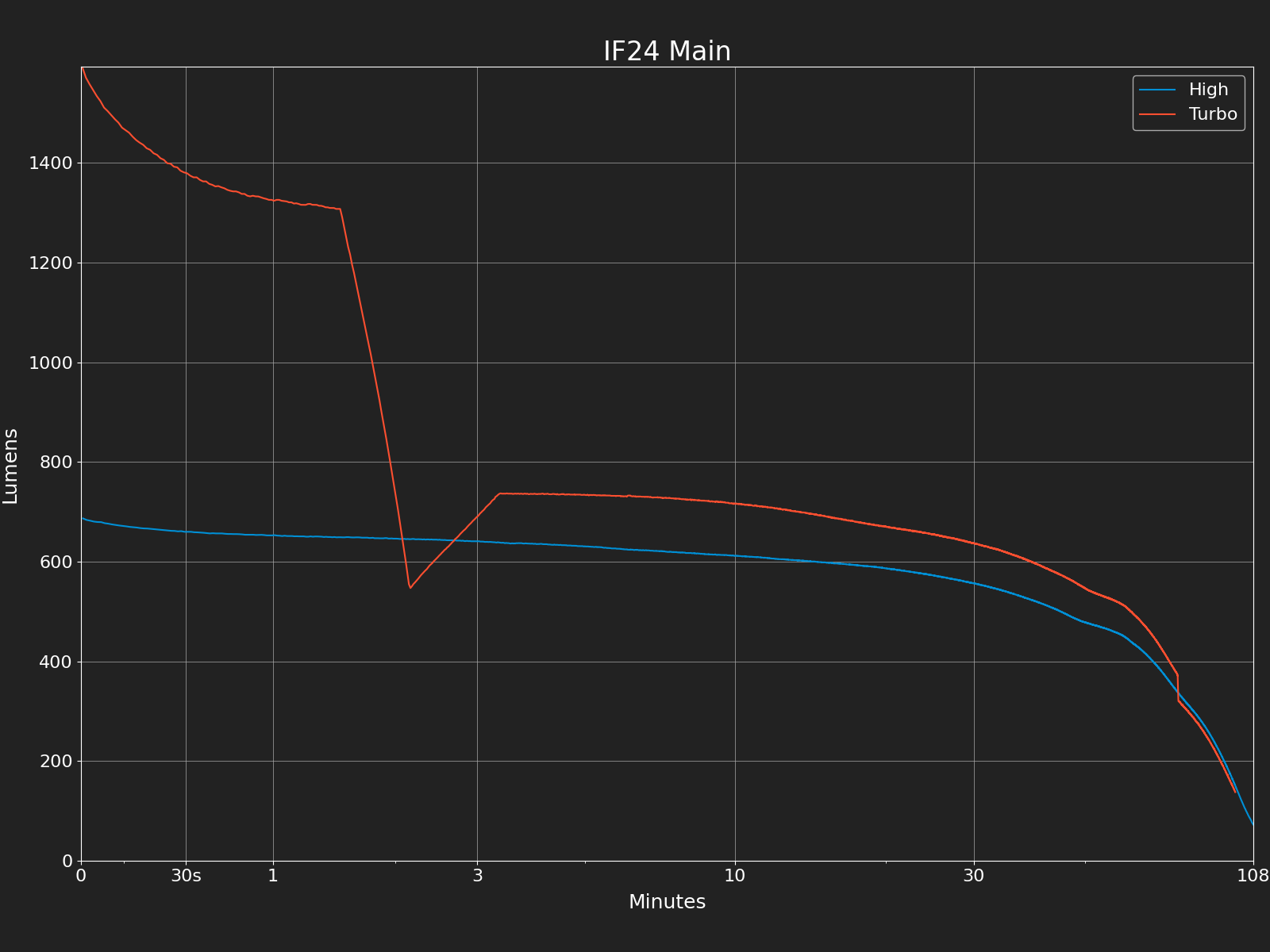
Side light
| Mode | Estimated lumens |
Time to 80% | Time to 50% | Time to 10% | Efficiency (lm/W) |
Current (mA) |
|---|---|---|---|---|---|---|
| Ultra-Low | 1 | 16.1 days | 36 | 6.73 | ||
| Low | 32 | 1.5 days | 105 | 74.6 | ||
| Med | 155 | 3.4 hours | 7.0 hours | 9.9 hours | 106 | 326 |
| High | 405 | 92 minutes | 3.0 hours | 4.1 hours | 118 | 760 |
| Turbo | 960 | 3.1 minutes | 43 minutes | 2.5 hours | 99 | 1900 |
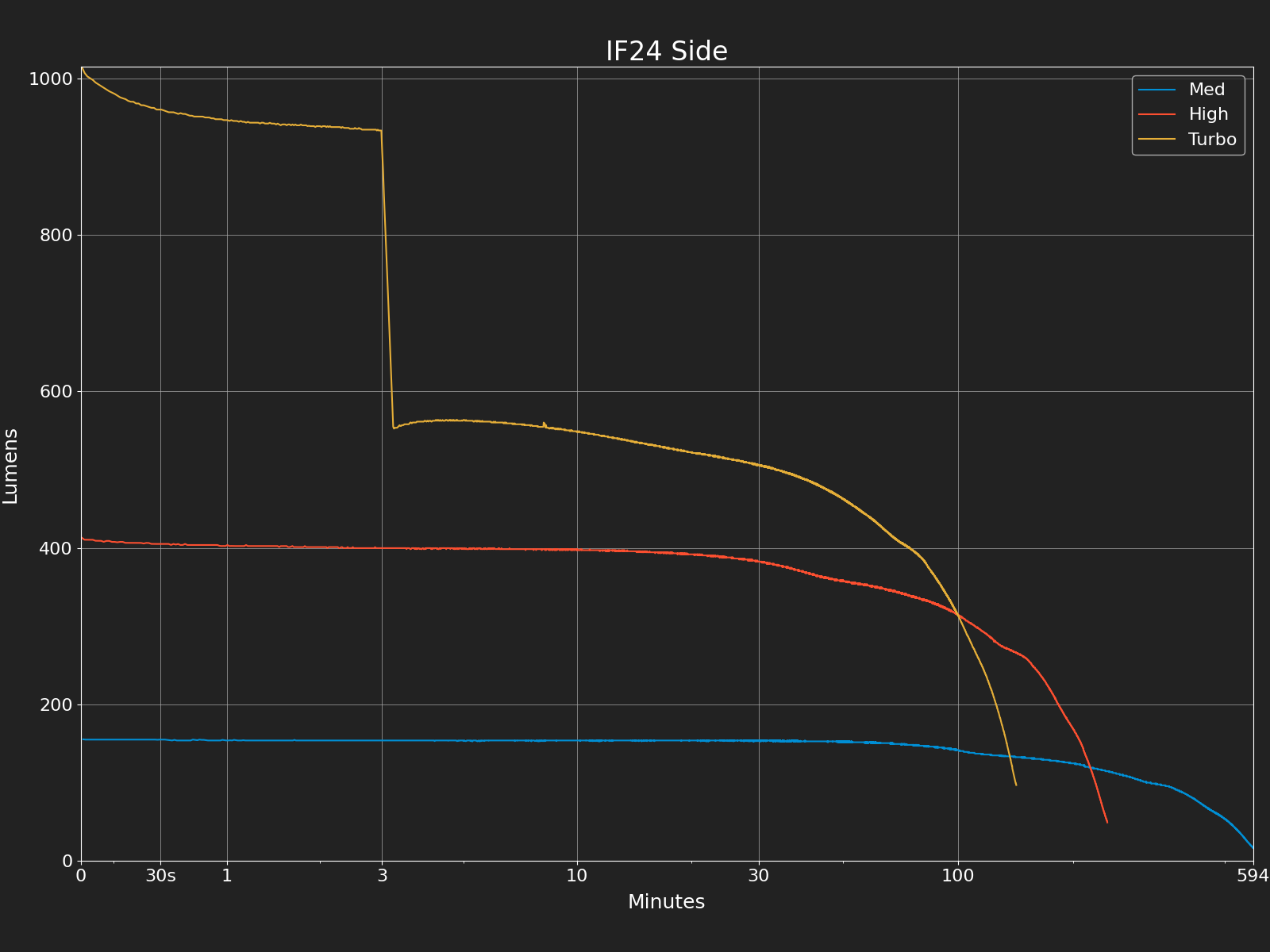
The colored LEDs draw about 145mA with output ranging from just over 20 lumens to 40. These are very rough output estimates, as I do not trust the calibration for non-white LEDs.
Beamshots
Main
Turbo, high, Zebralight SC64c LE for comparison
Tint vs BLF 348 and Zebralight SC64c LE
Side
Turbo, high, Zebralight SC64c LE for comparison
Tint vs BLF 348 and Zebralight SC64c LE
Color
Light quality
Readings are taken from the center spot diffused with DC Fix diffusion film using an X-rite i1Pro spectrophotometer.
Main light
| Mode | Color Temperature |
Tint Duv | CRI | CRI R9 (deep red) |
CRI R12 (deep blue) |
|---|---|---|---|---|---|
| Ultra-Low | 5668K | 0.0141 (2x extremely green) | 68 | -56.9 | 34.8 |
| Low | 6580K | 0.0038 (moderately green) | 67 | -41.3 | 40.8 |
| Med | 7254K | -0.0011 (slightly rosy) | 66.8 | -30.8 | 42.2 |
| High | 7218K | -0.001 (slightly rosy) | 67.5 | -29.3 | 42.6 |
| Turbo | 6867K | 0.0008 (neutral) | 68 | -32.4 | 42.8 |
Side Light
| Mode | Color Temperature |
Tint Duv | CRI | CRI R9 (deep red) |
CRI R12 (deep blue) |
|---|---|---|---|---|---|
| Ultra-Low | 6064K | 0.0029 (moderately green) | 92.2 | 86.5 | 73.8 |
| Low | 6064K | 0.0029 (moderately green) | 92.2 | 86.5 | 72.9 |
| Med | 5536K | 0.0049 (very green) | 92.6 | 59.9 | 76.2 |
| High | 5636K | 0.0044 (very green) | 93.1 | 62.8 | 75.5 |
| Turbo | 5505K | 0.0049 (very green) | 92.6 | 60.3 | 75.3 |
Batteries and charging
The IF24 uses one 18650 battery, and Sofirn's usual 3000 mAh button top is included. There are springs on both ends of the battery tube, and all 18650s I tested other than extremely long cells with USB charging ports are compatible. The light stays on constantly when vigorously shaken, even with unprotected flat-top cells.
There's a USB charging port on the body of the light, which can charge all compatible batteries. Both A-to-C and C-to-C cables work with every power supply I tested. Charging takes about 2.5 hours from empty.
Construction
While the IF24's construction is high-quality and rugged overall, I do have to fault it for not including a glass lens over its plastic TIR optic. This will lead to scratches.
Size and ergonomics
It wouldn't be fair to compare the size of the IF24 to single-function flashlights. It is larger than the average 1x18650 light, approaching the size of some lights using the larger 21700 battery. It's larger than my preferences for carry in a pants pocket, but adds significant functionality for that size.
It can be attached to surfaces using a magnet in the tailcap, which is held in by the spring and can be removed. I would prefer a stronger magnet.
Modification potential
The bezel is easily unscrewed allowing removal of the optic. Underneath is the LED and MCPCB, which appear easy enough for anyone with basic soldering skills to replace.
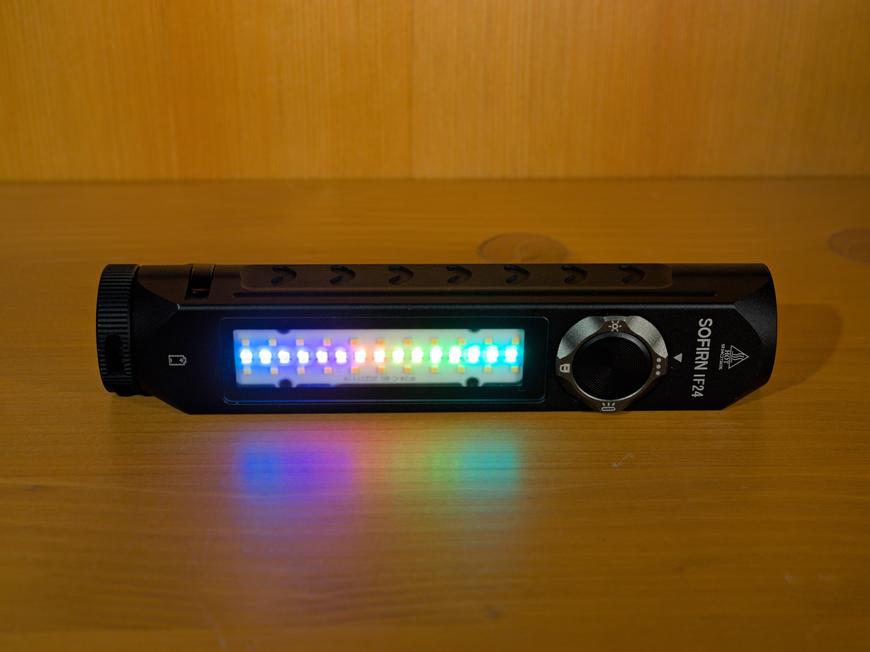

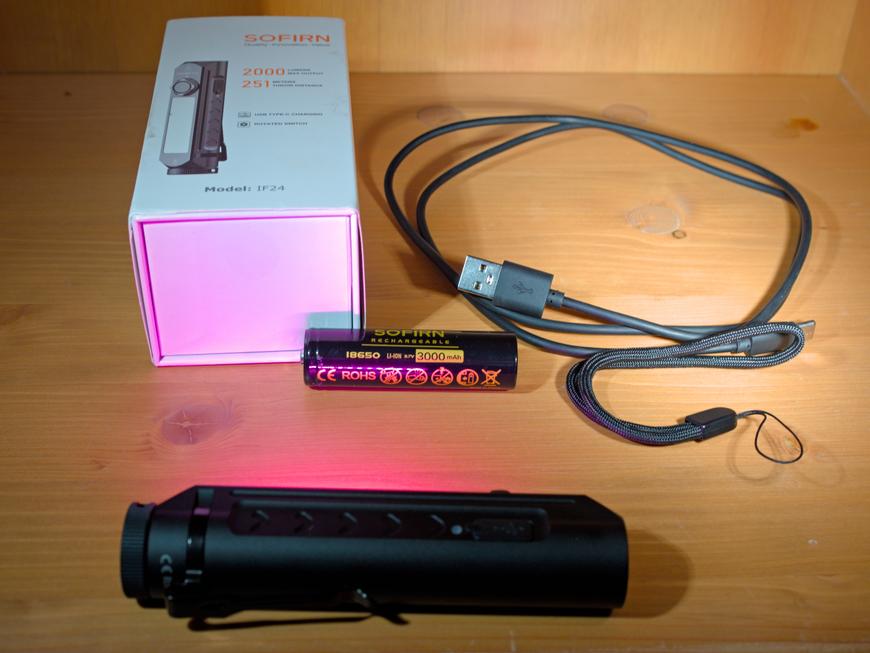
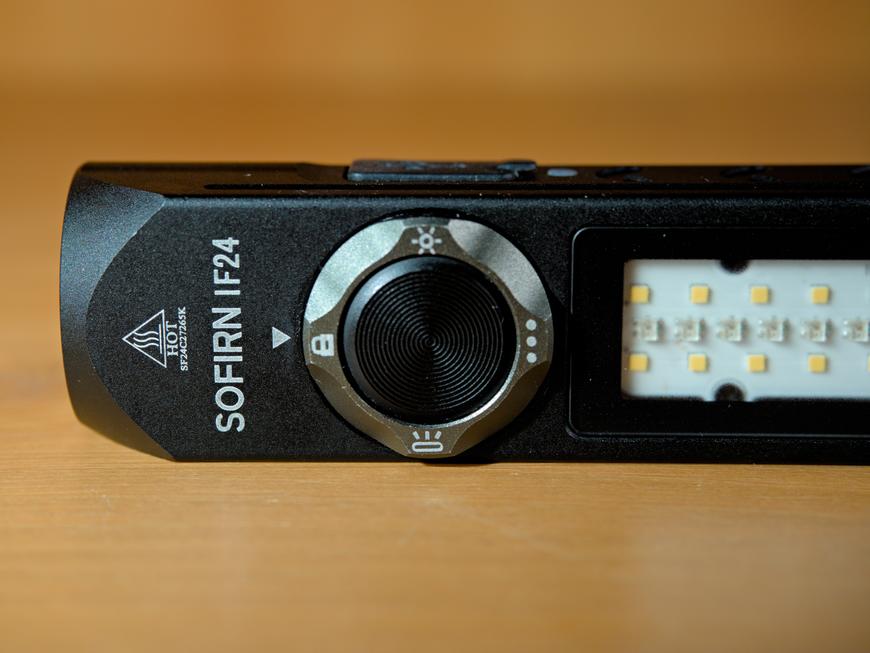
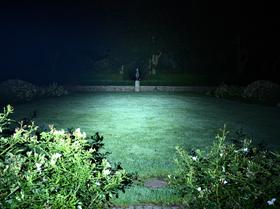


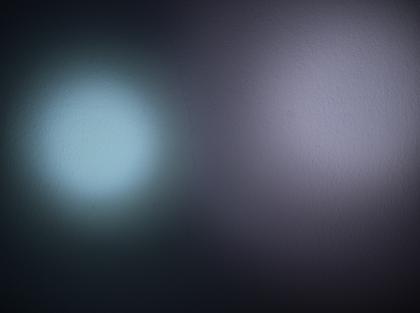

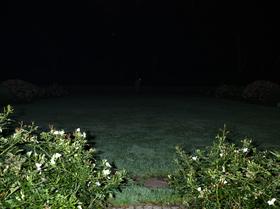
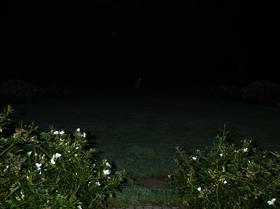
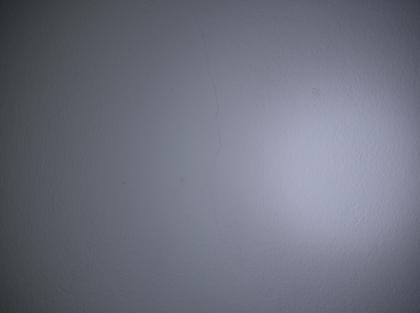

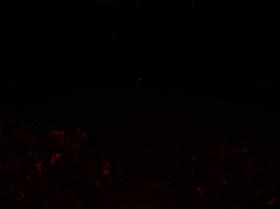
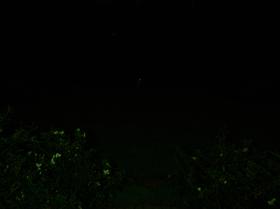
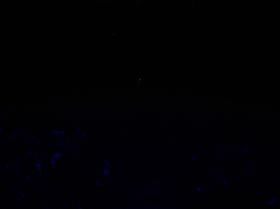

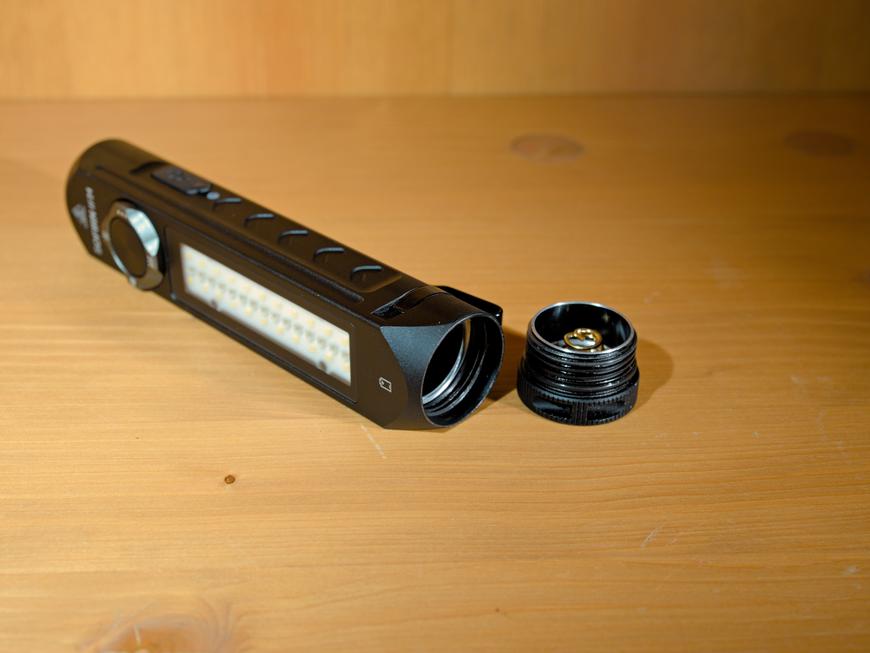

Comments
You can use your Mastodon or Lemmy account to reply to this
Reply Reply
Reply
Loading...